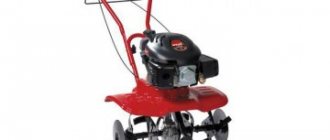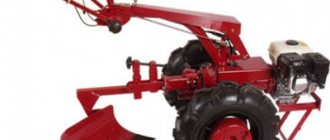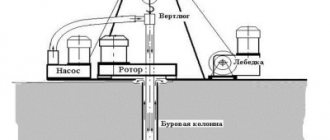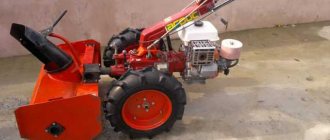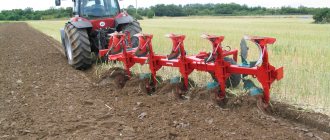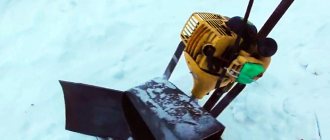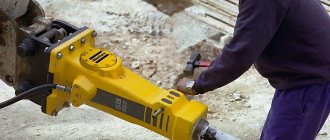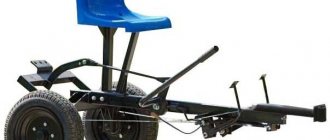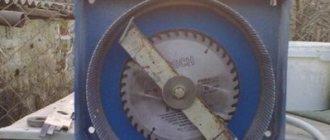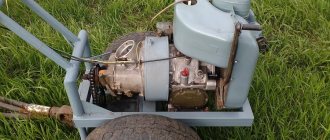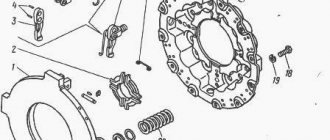Cultivator
- agricultural machine for tillage.
Cultivators are divided into steam
and
row-crop cultivators
. Steam cultivators are used for continuous cultivation of the soil before sowing, and row cultivators are used for cultivating crops. With the help of cultivators, loosening, weed control, moisture conservation, and hilling are carried out. Unlike a plow, a cultivator performs loosening without turning over the formation.
Cultivators can be equipped with passive (stationary) knives that perform work due to traction, as well as with active (driven) knives. Based on the type of drive, there are manual cultivators, motor cultivators, and cultivators mounted with a tractor.
Motor cultivator[ | ]
Main article: Motor cultivator
Motor cultivator
is a power unit designed for cultivating soil with cutters.
The main distinguishing features of a motor-cultivator from a walk-behind tractor are lower weight and the absence of a PTO (power take-off shaft).
The lighter weight of the cultivator makes it more mobile than a walk-behind tractor, which allows you to cultivate the soil with less effort, and also makes it possible to cultivate the soil in narrower areas.
Modern motor cultivators are equipped with various types of compact engines - gasoline two- and four-stroke, diesel, electric, powered by an electrical network or from a built-in battery.
Motorized cultivators are used everywhere, from small and medium-sized garden plots to large farms. Based on this, manufacturers produce light, medium, professional (heavy) motor cultivators.
Mounted cultivator for the MTZ 82 tractor: classifications, review
Most agricultural enterprises use MTZ 82 tractors to perform various soil cultivation tasks. Despite their popularity, their technological capabilities are limited.
Modern agricultural technologies require a high-quality approach to soil cultivation, which is provided by attachments. Several types and varieties of cultivators have been created for the MTZ 82 tractor, equally effectively cultivating the land.
Among them are traditional technology and its analogues, which make it possible to meet the needs of the agricultural sector at a high level.
Classification of mounted cultivators
The most popular and well-known method of destroying weeds is mechanical soil cultivation. Depending on the approach used, this can be done by cutting, tearing or backfilling.
Mounted tractor cultivators are special equipment that no agricultural enterprise can do without. It is designed for work in fields, forests and gardens.
In addition, mounted cultivators are widely used for developing virgin and hard soils.
Modern cultivating equipment is used to mix fertilizers with soil and level the surface.
The purpose of a mounted cultivator is determined by the generally accepted classification, which divides them according to:
- direction of use;
- operating principle;
- design features.
According to the direction of use, all mounted cultivators can be divided into three groups:
- Steam cultivators are used for complete destruction of weeds or leveling soil cultivation in preparation for sowing.
- Row-crop cultivators perform inter-row cultivation of various crops. It consists not only of weeding and destroying weeds, but also hilling. Such cultivators require a rigid clutch with the tractor to perform the task more accurately.
- Specialized cultivators are used for working in forests, gardens, and for caring for beet, melon, sugar crops and tea plantations.
Based on the principle of operation, passive and active equipment can be distinguished. In the first case, it is a conventional towed device that performs its functions using the draft force of the tractor.
Active cultivators are more technologically complex designs that work by connecting to the tractor with special coupling mechanisms that force the working parts to function.
For this purpose, the tractor power take-off shaft is most often used.
Working bodies are the main distinguishing feature of mounted cultivators. Depending on their design they are:
- disk;
- ploughshares;
- rotary units;
- cutters;
- hillers;
- chisel units, etc.
Aggregated mounted cultivators for MTZ 82
The agricultural machinery market offers dozens of mounted cultivators that are combined with the MTZ 82 tractor. Farmers most often use the equipment offered by MTZ-Holding, but there are also models from manufacturers in Europe and the USA.
Mounted cultivators differ from each other in a set of technical characteristics that you should pay attention to when choosing a suitable model:
- appointment;
- working width;
- type of processing;
- soil tillage depth;
- performance.
KPS – 4
Attached cultivator equipment, widely used for high-speed cultivation of land under fallow, for pre-sowing soil preparation when sowing winter crops without preliminary grinding of plant residues.
The unit is equipped with lancet working bodies. It can carry out processing at a speed of 12 km/h, with a productivity of up to 4.5 ha/hour. The width of the cutting surface is from 200 mm and the working area is 4 m.
KPSU-5U
Cultivation complex for continuous soil cultivation. Performs pre-sowing treatment and fallow care with simultaneous harrowing. The width of 10 cutting surfaces is from 270 mm and the working area of the grip is up to 5 m. Productivity is 5.5 ha/hour, with a penetration into the soil of up to 12 cm.
Bomet
5-body cultivator-hiller Bomet made in Poland, the main purpose of which is to cultivate inter-row soils on potatoes, tobacco, peppers and all kinds of root crops grown on beds with a width of 60 to 75 cm. It is used for removing weeds, hilling and forming rows. Equipped with 5 hillers, 5 pointed paws and 10 paws for loosening.
Vepr - 3.8N, 4.2N
Mounted cultivators for the MTZ 82 tractor from a domestic manufacturer. Designed for preparation for sowing or complete soil cultivation with rolling, harrowing, cutting the roots of weeds. The design uses lancet implements and a mechanism for adjusting the soil depth. We received an objective engineering assessment of the design characteristics.
Source: https://traktorspec.ru/oborudovanie/navesnoj-kultivator-na-traktor-mtz-82-klassifikatsii-obzor.html
Forest cultivators[ | ]
Forest cultivators are designed for soil reclamation in plots (forest areas) allocated after clear-cutting for use. The peculiarity of such work lies in the obviously more difficult conditions: the presence of a large number of stumps and logging residues. The Scandinavian countries and the North-Western regions of Russia are characterized by rocky areas. All these conditions were taken into account when creating forest cultivators.
Such cultivators are installed on forestry machines - forwarders and skidders of various manufacturers. The executive bodies of such equipment are driven by the hydraulic system of the base machine. Control is carried out through a modern and at the same time quite simple computerized system of our own development, Bracke Growth Control.
There are two types of cultivators: disc cultivators and discrete micro-raising cultivators. The first type refers to harrows with an active drive to a loosening disc. The second type of cultivator is based on the implementation of the theory of micro-increases - a double inverted layer of humus, a specially created seat with optimal conditions for the rapid growth of seedlings.
- Share cultivator
- Cultivator with pointed tines
- Pointed foot
- Another type of pointed paw
- Small-sized motor cultivator
- Motor cultivator "Mole"
Mounted and trailed cultivators of the “Twist” series for continuous/pre-sowing tillage
Mashinostroitelny produces trailed and mounted cultivators for continuous tillage with a working width from 4 to 12 meters. Our agricultural machinery meets the requirements of agricultural professionals for soil cultivation. The model range meets the needs of both small farmers using MTZ-80 and HTZ-201 tractors, and agricultural holdings using heavy-duty machines Kirovets K774 P, Terrion ATM 7360, New Holland T8040, etc.
| Indicators | Twist-4 | Twist-8 | Twist-10 | Twist-10M* | Twist-12 | Twist-12M* | |||||||
| Working width, mm | 4 000 | 8 000 | 10 000 | 10 000 | 12 000 | 12 000 | |||||||
| Equipment, to choose from | with slatted/spiral roller and 2-row harrow | ||||||||||||
| Productivity, ha/hour | 3,2-4,8 | 6,4-9,6 | 8,0-12,0 | 8,0-12,0 | 9,6-14,4 | 9,6-14,4 | |||||||
| Structural weight of the implement, kg | 1800 | 3400 | 4600 | 4800 | 4985 | 6000 | |||||||
| Tillage depth, cm | 4…12 | ||||||||||||
| Number of gun sections, pcs. | 1 | 3 | 3 | 3 | 3 | 5 | |||||||
| Number of working parts of the implement, pcs. | 23 | 47 | 59 | 58 | 71 | 70 | |||||||
| Number of rows of working bodies, pcs. | 4 | 4 | 4 | 3 | 4 | 3 | |||||||
| Paw width, mm | 230 | ||||||||||||
| Paw spacing along the trail, ~ mm | 170 | ||||||||||||
| Bellota rack parameters, mm | 65x12 | ||||||||||||
| Press roller diameter, mm | 400 | ||||||||||||
| Number of teeth in the harrow, pcs. | 26 | 52 | 68 | 68 | 80 | 80 | |||||||
| Tractor power (class), hp | from 70 (1.4) | from 150 (3) | from 200 (4) | from 200 (4) | from 250 (5) | from 250 (5) | |||||||
| Operating speed, km/h | 8…12 | ||||||||||||
| Transport speed, km/h | no more than 25 | ||||||||||||
| Number of support wheels, pcs. | 2 | 4 | 6 | 8 | 6 | 12 | |||||||
| Diameter of trailed hitch (drawbar), mm | 55 | ||||||||||||
| According to the type of clutch with the tractor | semi-trailer | ||||||||||||
| Overall dimensions in working position (l/w/h), mm | 5950/4300/1300 | 5950/8450/1300 | 7100/10700/1450 | 8800/10200/1250 | 7100/12700/1450 | 8800/12200/1250 | |||||||
| Overall dimensions in transport position (l/w/h), mm | 5950/4300/1600 | 5950/4200/3850 | 7100/5200/4300 | 6400/4300/4000 | 7100/5200/5000 | 6400/4300/4000 | |||||||
| Warranty period, months. | 12 | 12 | 12 | 12 | 12 | 12 | |||||||
Bellota S-shaped tines with durable 230mm wide winged feet vibrate around obstacles and reduce the build-up of wet soil. The arrangement of working bodies used guarantees high-quality pruning of weeds, loosening of the surface layer and formation of a pre-sowing bed.
Depending on the type of soil, the cultivator is equipped with a roller attachment, a harrow-roller attachment, slatted or spiral rollers; they finally crush lumps, blocks, roll and level the soil. The tillage depth is adjusted using thrust screws. Ideal geometry (accuracy up to 3 mm over the entire length of the frame) is maintained due to the lanyard and the pyramidal design of the frame. The system for stabilizing the position of the working bodies allows you to clearly maintain the depth of tillage.
The hydraulic system, coupled with the cultivator chassis, allows you to lift the working parts when turning at the edge of the field. To bring the cultivator into the working position after turning, it is enough to release the pressure from the chassis hydraulic cylinders, and the implement will continue cultivating to the specified processing depth. The configuration of the mounting posts minimizes their clogging with plant debris. The articulated frame ensures that each section of the cultivator follows the terrain.
Advantages of the Twist cultivator:
- reliable supporting frame made of structural steel 09G2S;
- parameters for soil cultivation are configured;
- the processing depth is clearly maintained;
- performs cultivation, loosening, leveling and compacting the soil in one pass;
- easy to maintain in the field.
Our regular customers are farms and agricultural holdings in the South of Russia. You can find Twist pre-sowing cultivators in the fields of the Krasnodar and Stavropol Territories, the Rostov Region and the republics of the North Caucasus - Chechnya, Karachay-Cherkessia, Adygea, Kabardino-Balkaria, Ossetia, Dagestan, Ingushetia.
Cultivators for tractor
Cultivators are one of the most popular types of attachments. Suffice it to recall the cultivators KSHU, Smaragd, John Deere, KLB. They have many different uses. With the help of such a hitch you can loosen the soil and crush large clods of earth.

Emerald
Cultivator Husqvarna
The Polaris cultivator can perform not only loosening the soil, but also much more. In particular, it is capable of carrying out soil leveling work. The use of the KSK cultivator can be considered universal in terms of the number of operations performed. It is also possible to use it to level the soil, compact the soil and do other types of work.
Important! Tilling the soil with a tractor cultivator has an important feature: in this case, there is no impact on the soil without turning it around.
The main types of cultivators used as hanging equipment:
- Disk devices. Here the working part is vertical sharp disks that cut through the soil when moving. They loosen the soil, making it more moisture-absorbing, promoting its aeration. This processing is much more effective than manual processing using a fork.
- There are continuous tillage cultivators that use pointed knives. They are installed in such a way that during processing they tear up the turfed ground without affecting the deeper layers. Such careful processing on chernozem does not mix the fertile soil layer. These devices are called mechanisms with pointed guns.
- Plowshare cultivators incorporate a plow into their design, but they do not perform conventional plowing. In this case, the ploughshare does not wrap around the soil during operation. Distinctive features of such devices are their wide coverage and the ability to connect to low-power tractors.
- The soil cultivation carried out by a milling cultivator is carried out to a depth of 35 cm. As a result of milling, the cut weeds are intensively mixed with the soil.
- Chisel mechanisms carry out plowshare cultivation of the soil. In this case, several cutting tools are used in one device. When processing, such a wide-cut chisel does not wrap the soil.
- Trailed forest cultivators are capable of cultivating soil whose surface layer consists of compacted dry leaves and old grass.
- Discrete micro-raising cultivators are designed to work in areas where the terrain is uneven. Despite the unevenness of the soil, this type of device ensures complete processing.
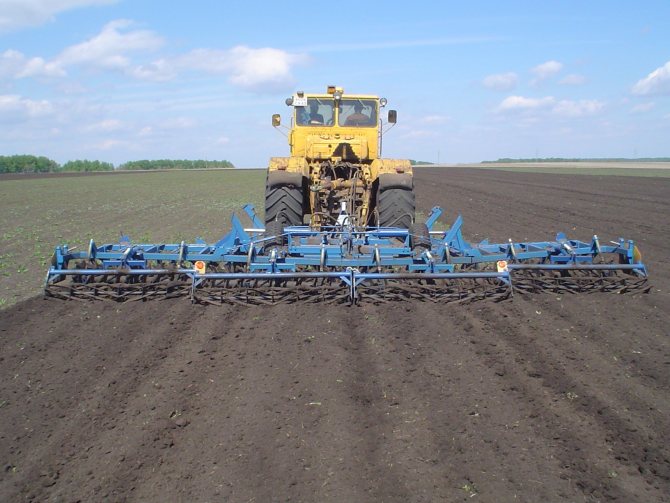
cultivator-on-mtz
